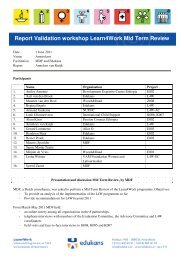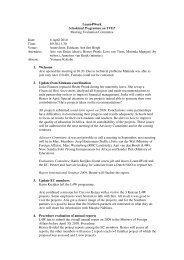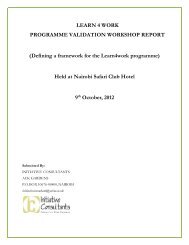Non â Formal TVET Mapping Survey Supported by Edukans ...
Non â Formal TVET Mapping Survey Supported by Edukans ...
Non â Formal TVET Mapping Survey Supported by Edukans ...
You also want an ePaper? Increase the reach of your titles
YUMPU automatically turns print PDFs into web optimized ePapers that Google loves.
<strong>Non</strong> – <strong>Formal</strong> <strong>TVET</strong> <strong>Mapping</strong> <strong>Survey</strong> The case of Amhara, Oromia and Addis Ababa<br />
~ School dropouts and those with grade 8 - education or lower including illiterate<br />
people,<br />
~ People potential /active in the informal economic sector,<br />
~ People from urban and rural areas,<br />
~ Landless poor, and<br />
~ Disadvantaged groups<br />
~ People with disabilities<br />
<strong>Non</strong>-formal <strong>TVET</strong> differs from formal <strong>TVET</strong> in the following respects:<br />
The educational background of the target groups is different and very diverse.<br />
Teachers/trainers/instructors are so far usually not certified or examined.<br />
There are no standardized curricula to be used in non-formal <strong>TVET</strong> provision.<br />
The duration of training is usually shorter and varies widely.<br />
<strong>Non</strong>-formal <strong>TVET</strong> is more cost effective than formal <strong>TVET</strong>.<br />
With this understanding of <strong>Non</strong>-formal <strong>TVET</strong>, this survey was designed to carry out a<br />
mapping survey of NF – <strong>TVET</strong> in Ethiopia to identify and list the current information<br />
and data regarding the program focusing on partner organizations. The survey is also<br />
designed to obtain updated information about the overall picture of the modalities, their<br />
status, scope and targets.<br />
The out put of the survey document will enable to initiate effective NF-<strong>TVET</strong> programs<br />
to create self- employment opportunities, improve the quality of small-scale industry<br />
products, agricultural outputs, increase income, improve the livelihood of target groups,<br />
enhance competitiveness and finally contribute to the overall poverty reduction and<br />
sustainable development in Ethiopia.<br />
1.3. The Rationale behind the <strong>Mapping</strong> study<br />
Ethiopia, with a population of 73 million in 2005 (National Office of Population, 2005)<br />
and an annual population growth rate of 2.9% in 2004 (World Bank, 2006), is the third<br />
most populous country in Africa. With a real GDP (Gross Domestic Product) per capita<br />
of about $ 150 (Australian Government, 2006), it is one of the poorest countries in the<br />
world. According to Plan for Accelerated and Sustained Development to End Poverty<br />
(PASDEP), 62% of the adult population in Ethiopia is illiterate (2004). The labor force<br />
population (age 15 - 64) for the year 2005 was estimated at 40 million (National Office of<br />
Population, 2005). Out of these, only a total of about 531,584 youth and adults were<br />
enrolled in education and training of which, 90,759 took part in secondary education,<br />
106,338 in (public and non-public) <strong>TVET</strong>, and 95,811 in (undergraduate) higher<br />
education (MOE, 2004/05; IIZ/DVV, 2006).<br />
Despite the expansion of formal <strong>TVET</strong>, it only caters for less than 3% of the appropriate<br />
age group (<strong>TVET</strong> Strategy, 2006). On the other hand, even if there are fragmented efforts<br />
endeavored <strong>by</strong> different actors of NF – <strong>TVET</strong> (government, public, private and NGO) the<br />
result has not been registered. Little is known about what poor people in rural and urban<br />
areas, women groups, pastoral groups, and the landless, etc are benefiting from NF<strong>TVET</strong>.<br />
Education Expertise Center Feb 2008 9







